In: curated

Xiaojing Yan
February 1, 2022Stepping into an exhibition by artist Barry Ace is a transformative experience. The bold colour palette, the textural combination of materials, and the meticulous attention to detail quickly captivates you. The entanglements of these elements reveal unique narratives that change the lens through which we see others. Suzanne Luke offers some thoughts on the art an ideas of Barry Ace in this article.
Read More
Stéphane Alexis’ Chains & Crowns
January 23, 2022Stéphane Alexis’ Chains & Crowns Rita Godlevskis Stéphane Alexis from the Chains & Crowns series, 2020 It is clear, even at... Read More

Zhang Xiaogang | Girl and Tree, 2007 – 2008 – December, 2021
December 29, 2021Zhang Xiaogang | Girl and Tree, 2007 – 2008
Several years ago, a friend suggested Jan Wong’s book Red China Blues: My Long March From Mao to Now to me. It was a memoir that touched upon major historical events, but always with a personal stance of Wong’s experiences as both the child of Chinese immigrants to Canada, but also as a person who, as a teenager in the late 1960s, was enamoured of Mao Tse Tung, and lived for some time in China during the Cultural Revolution. Years later – as chronicled in the book – she would be in Beijing when the Tiannamen Square Massacre happened. It’s a good book: Wong is a meticulous narrator, and spares neither her young self, nor larger mythologies of the State (whether China or Canada) from an older, wiser voice of criticism.
When I first encountered the work of Zhang Xiaogang, Wong’s stories of the Cultural Revolution (which she was protected from, being a Canadian still too anaesthetized by ideology over reality) immediately came to mind. Zhang’s figures are grim: they also make me recall a ‘joke’ from another friend, whose family fled communist Poland, about ‘Soviet photo face.’ This is the idea – which any cursory review of official photography from the USSR, or any totalitarian state, really, will reveal – that you must offer a facial expression, in all images, that is neutral, lest it be used against you later, and you find yourself in the gulag or a re education camp.
“Inspired by contemporary tensions in China, Zhang Xiaogang makes grim, unsettling portraits that consider identity and heredity in a collectivist state. The artist draws on influences that include political iconography, Chinese charcoal drawings, distorted Surrealist compositions, and family portraits from the Cultural Revolution era. His paintings, often executed in grisaille with bursts of bright yellow or red at the center, explore how varied individual histories are flattened into conformist representations.” (from here, where you can enjoy more of Zhang Xiaogang’s artwork) ~ Bart Gazzola
Read More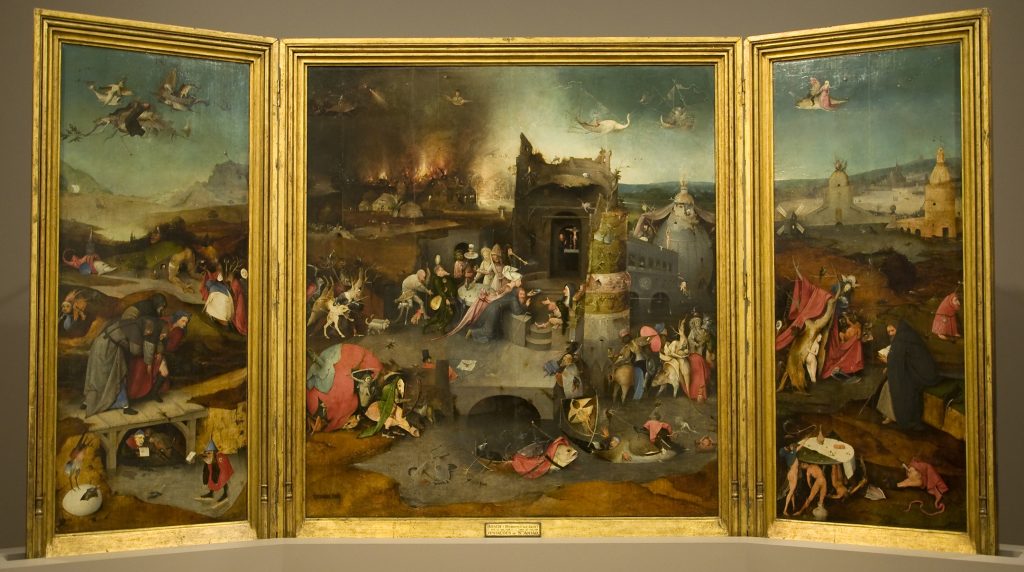
Temptation of Saint Anthony | Hieronymus Bosch
January 18, 2022High culture has pretty much disappeared along with the dress code.
Read More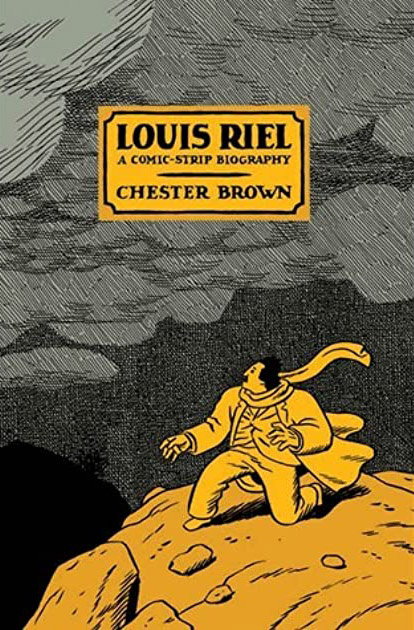
Louis Riel | Chester Brown, 1999 – 2003
February 23, 2022Louis Riel | Chester Brown, 1999 – 2003
Drawn & Quarterly, 2003
It seems an appropriate time to revisit Chester Brown’s excellent graphic novel Louis Riel (A Comic – Strip Biography), with Louis Riel Day having recently passed. I also say this not just due to recent domestic terrorism in Ottawa, but also as when I was living in Saskatoon, with a statue of Riel’s ally Gabriel Dumont prominently installed near the South Saskatchewan River, the reality of contested narratives about history was necessary to consider. An ongoing debate in Niagara, about a statue of a soldier glorifying the North-West Rebellion being removed from St. Catharines city hall, indicates this isn’t solely a regional concern.
More to this point: an exhibition at the now defunct Mendel Art Gallery a few years ago, on the work of James Henderson, displayed a full scale portrait of the judge who presided over Riel’s ‘trial’, where his execution was a foregone conclusion, and this fact was – still – not particularly welcomed when imparted to various tours and visitors.
“Chester Brown reinvents the comic-book medium to create the critically acclaimed historical biography Louis Riel, winning the Harvey Awards for best writing and best graphic novel for his compelling, meticulous, and dispassionate retelling of the charismatic, and perhaps insane, nineteenth-century Métis leader. Brown coolly documents with dramatic subtlety the violent rebellion on the Canadian prairie led by Riel, who some regard a martyr who died in the name of freedom, while others consider him a treacherous murderer.” (from here)
One of many fine publications from Drawn & Quarterly, this is one of a number of Brown’s excellent comics, and has been cited, along with Jeff Lemire (with his anthology Essex County) as an example of how ‘comics’ in Canada are engaging with historical narratives that are very relevant today.
Minimalist in format, this text fills in gaps that many of us were left with, studying history in school. Several years ago, in conversation with people from various parts of Canada, it was telling that Riel had been demonized in some historical accounts, completely ignored in others and given a more honest treatment in others. It’s an overused quote, but seems apt here : My people will sleep for one hundred years, but when they awake, it will be the artists who give them their spirit back. (Riel, as cited in The Defiant Imagination : Why Culture Matters (2004) by Max Wyman)
Louis Riel was the first comic book to receive a grant from the Canada Council for the Arts and has won three Harvey Awards.
A preview can be seen here and it can be purchased from Drawn & Quarterly, if you can’t find a copy at your local library. ~ Bart Gazzola
Read More
The Museum of Everything: Volume #4 – You’re Not Only Human
January 24, 2022The Museum of Everything: Volume #4 – You’re Not Only Human
Everything Ltd/The Museum of Everything
The Museum of Everything
I have collected a lot of catalogues over the years. Some for shows I’ve visited in person, and some for shows I simply wish I had visited. In 2013, I visited the Venice Biennale. It was pure serendipity that the inspiration (and title) for the 2012 iteration, curated by Massimiliano Gioni, was The Encyclopedic Palace: the concept first patented in 1955 by self-taught artist, Marino Auriti, of an imaginary museum “meant to house all worldly knowledge, bringing together the greatest discoveries of the human race, from the wheel to the satellite.”
Having focused a great deal on ‘outsider art’ during my Masters degree, I was bonkers thrilled to be able to see an exhibition carrying this much weight on the international level, blurring the lines between self taught and academic artists. Aside from the spectacle that was the main exhibition, one of the greatest finds for me was a tiny little pavilion set up outside by The Museum of Everything. Wandering through their set up of reproductions of work by Carlo Zinelli, mounted on pillars, I ended up at their bookstore/gift shop and found one of my most prized possessions to this day.
The Museum of Everything was launched by James Brett in Britain in 2010, and has quickly grown into an institution celebrating who they refer to as, “untrained, unintentional, undiscovered and unclassifiable artists of modern times”. This particular catalogue documents their fourth exhibition, which was presented at Selfridges, London from September 1 – October 25, 2011. The exhibition presented over 500 artists, including the first UK retrospective of Judith Scott – a personal heroine of art-making. The catalogue includes 225 pages of full colour works, organized into categories of studios. Prior to this catalogue, I had been aware of some of the more well known studios/organizations/institutions, like Creative Growth, Gugging and Creativity Explored, but the index provided me with a blueprint for places I would grow to research more, to study, to acquire works from, and to include in exhibitions I dreamt up. Each section includes reproductions of works, alongside statements by the studios they were created in, and cursory descriptions of the artists’ general oeuvre. The catalogue almost becomes a collection of manifestos of support for those creating outside of the academic tradition.
Included in the boxed set is The Appendix of Everything, featuring interviews with heavy hitters like Cindy Sherman, Massimiliano Gioni, David Byrne, and revered director of White Columns, Matthew Higgs. The collection of conversations is informal, accessible, and honest. Many quotes have stuck with me to this day. One in particular, was Higgs’ description of what he felt when he first encountered Creative Growth. “Art was being made for reasons that remained out of reach”. For me, this is the art I’ve developed a tidal wave of emotional reaction to. I look through this catalogue regularly, finding patterns, similarities, moments of clarity, and moments of joy.
You can acquire this catalogue by visiting the Museum of Everything’s website. Also note that there are now 7 catalogues for exhibitions curated by the Museum. ~ Lisa Kehler
Read More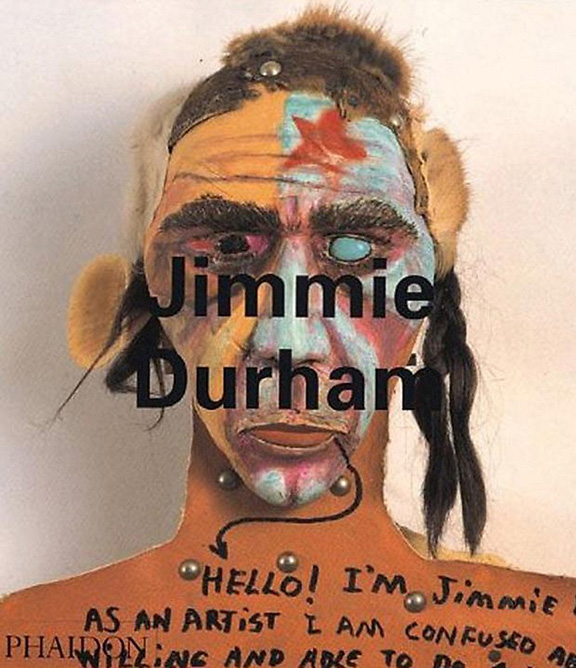
Jimmie Durham
January 21, 2022Jimmie Durham
Essays by Laura Mulvey, Dirk Snauwaert, Mark Alice Durant, Kate Nesin
240 illustrations
London: Phaidon, 1995
Jimmie Durham (1940 – 2021) passed away last year, and it’s an appropriate time to consider his legacy and his art. This book from Phaidon was originally published nearly two decades ago, and has been reissued recently, with some updates and further considerations about the artist, his work, and the controversy that suffused his practice, especially around his claims of Cherokee descent.
From Library Thing: “Jimmie Durham is an internationally acclaimed artist, writer and poet of [alleged] Cherokee descent. His intricate sculptures and installations mimic the attributes of human beings and animals, and the ways they make or are made into history. Durham collages discarded objects and fragments of organic matter, transforming them with dazzling colour into startling, anthropomorphic configurations. His ersatz ethnographic displays deliver ironic assaults on the colonizing procedures of Western culture. An activist in the American Indian movement during the 1970s, he has also published poetry, fiction and critical theory. Featured at Documenta 9 (1992), his work has also been exhibited at the Whitney Museum of American Art, New York, and the Institute of Contemporary Arts, London. The Survey by British film and art critic Laura Mulvey, author of ‘Visual Pleasure and Narrative Cinema’ and other influential essays, explores themes of history and language, space and time in Durham’s work. Belgian curator Dirk Snauwaert talks with the artist about his multi-faceted practice. In the Focus, Mark Alice Durant, US performance artist and writer, analyzes Durham’s diary of Shakespeare’s Caliban. For Artist’s Choice, Durham has selected texts by Italo Calvino about the loss of speech and the poetry of the invisible. Artist’s Writings include essays, poems and a screenplay published here for the first time.”
Durham is a very contested figure, and his artwork falls within that narrative, too. The exhibition Jimmie Durham: At the Center of the World came to the newly opened Remai Modern in Saskatoon, Saskatchewan, Canada, in 2018 – at the same time that his claims of Cherokee heritage were being hotly contested. As one of the first shows in that gallery, in a place that has often been referred to as the ‘Alabama’ of Canada for its systematic racism, it fired a number of arguments (not the least of which spilled back on some of the critics of Durham, who are associated with the University of Saskatchewan, perhaps as projection from their own issues with institutional racism and attempting to appropriate Indigenous identity to further exploit those communities). At the Center of the World could be seen as the spark that lit that situation, which is still burning….
I cite that to show how Durham’s aesthetic and ideas merit a re examination as they engage with experiences and histories that are being played out in numerous sites around Canada, if not the world, and this book (considering with Durham’s recent passing that readers might contemplate Durham’s life as a whole) allows for his life and legacy to be considered in a more ‘complete’ manner.
I’m familiar with the original edition of the book, but there is an updated edition, from Phaidon, which you can see more about here. ~ Bart Gazzola
Read More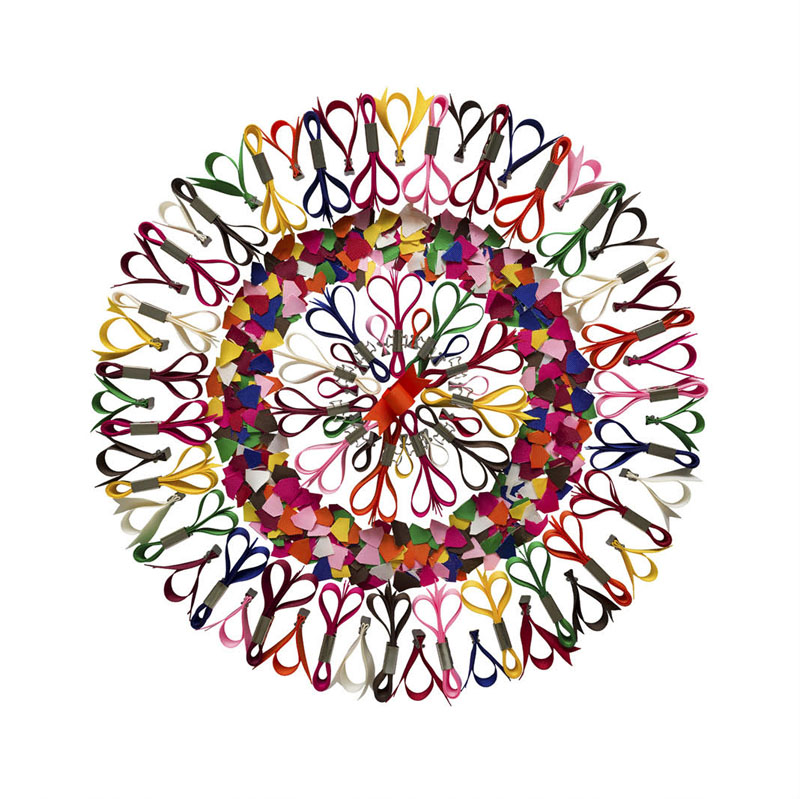
Leslie Hossack | Ribbon of Tears No. 8
December 13, 2021Leslie Hossack | No. 8
Leslie Hossack is an Ottawa photographer who created this image as part of a series of 11 pieces reflecting on the devastation of residential schools.
Hossack describes these works as follows:
“These photographs are my response to the ongoing tragedy of Canadian residential schools. The compositions were inspired by memories of my own childhood – ribbons, crayons, kaleidoscopes, pinwheels. I felt cared-for and carefree. That is what I wish for every child.
I hope these images will provide a starting point for conversations about the history and legacy of residential schools – conversations building towards truth and reconciliation. Ribbon of Tears is dedicated to all those robbed of their childhood by residential schools.”
Artist’s Note: These photographs are not for sale commercially. However, prints can be ordered directly through Toronto Image Works at a cost of 30% off the list price.
More images by this artist can be enjoyed at her Instagram account here and at her website ~ Peppa Martin
Read More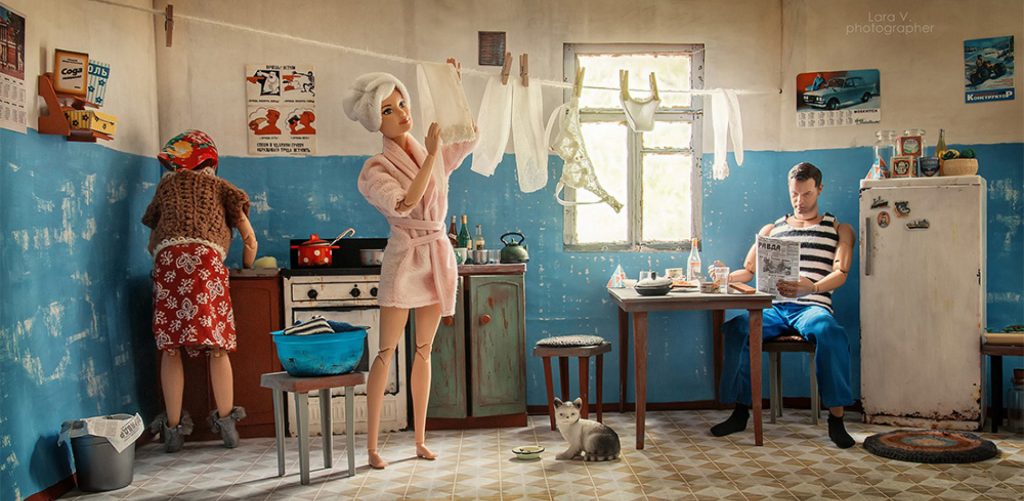
Lara Vychuzhanina | The life of Barbie and Ken in the Soviet Union
November 30, 2021Lara Vychuzhanina | The life of Barbie and Ken in the Soviet Union, 2017
First as tragedy, then as farce, we were warned a long time ago by Marx, is how history will play out. That’s a bit damning, but as we make our way further into the 21st century, it’s to be forgiven if many of us also see a more black than bleak humour in all this, a dark comedy that still makes us laugh, inappropriately.
Lara Vychuzhanina (whose Instagram name is aptly @lara_art_dolls) is a Russian photographer from Yekaterinburg – formerly known as Sverdlovsk, during the Soviet era, which I mention as it intersects with some of the ideas present in her work here, where she’s created a tableaux of Barbie and her partner Ken living in the USSR in the 1980s.
There’s always an element of nostalgia in depictions of history, allusions to a ‘simpler time’, and it’s interesting to see one about the USSR, as in the West we’re usually inundated with this false trope about the 1950s, or 1960s: Lara Vychuzhanina is too young to remember the 1980s in the former Soviet Union, but this doesn’t stop others from offering caustic and contested interpretations of those eras, either. Employing Barbie and Ken for this is a nice intersection of mythologies of East and West, capitalism and communism, plasticity and reality – and it is also, in the inherent contradictions of its assemblage, very funny.
After all, “comedy is in act superior to tragedy and humourous reasoning superior to grandiloquent reasoning” (which, fittingly, is attributed to Friedrich Engels by Karl Marx, back in 1862)…..
More images by this artist can be enjoyed at her Instagram. ~ Bart Gazzola
Read More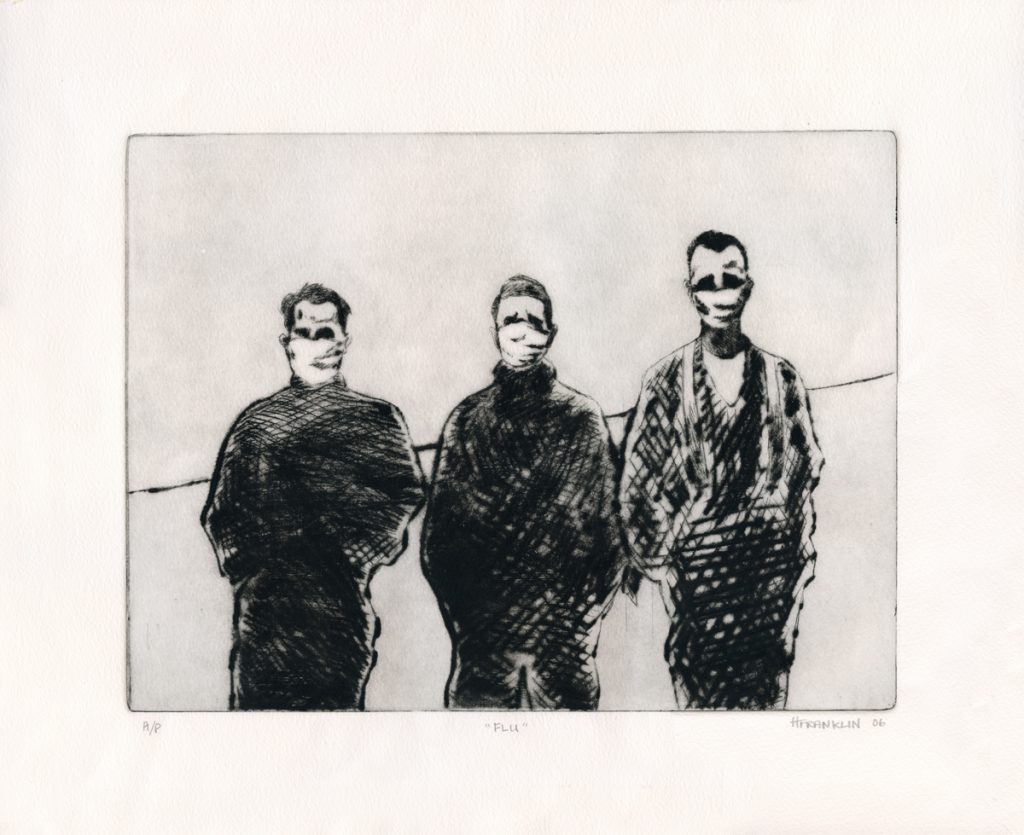
Heather Franklin | Flu
November 22, 2021Context is everything.
I first saw Flu, by Heather Franklin, in 2010. Heather, the Director of The Button Factory, Waterloo Ontario’s Community Arts Centre, made this drypoint print in 2006, drawn from a photo of three men during the Spanish Flu epidemic in 1918.
What drew me to the image was its strangeness. Three men, obviously out of doors (as indicated by the skewed horizon line, so likely to be farmers), in masks, facing an invisible, deadly threat. The title gave away the timeline and narrowed the reason for their masked anonymity to a necessity rather than a choice – they were not running from the law. But the masks still made them “others”, unrecognizable, in a situation I could not fathom. The print carried with it a sense of the uncanny, with a deep sense of foreboding.
In 2021, these men have become very knowable. They are us. They are simple people, dealing with a situation beyond their control in the simplest way they can. Now I find myself less concerned with the contagion swirling around them than with the economic straits they find themselves in, how their families are coping, whether or not they have lost loved ones. They have become human where once they were alien.
You can find more of Heather’s fine illustrations on her Instagram account @heathersphotophoto.
~ Mark Walton
Read More
Recent Comments